What Is Track Lighting? - A Buyer’s Guide

There are more lighting options for residential and business spaces than ever before. Lighting is incredibly versatile; you can use it to brighten up a room or set a calming mood. But, having so many options can be overwhelming and confusing. In order to help provide some clarity on the subject, we’ve compiled an easy overview of the types of track lighting to help guide your buying journey.
What Is Track Lighting?
There are so many different stylistic options when it comes to lighting your home. Track lighting is a popular option thanks to its incredible versatility and the amount of track lighting options given to consumers. This type of lighting fixture features a series of lamps connected to a support track that’s mounted to the ceiling.
Track lighting is often thought of as a very simple collection of pendants or heads connected to a metal strip on the ceiling. However, there’s so much more to it than that. You can choose a track lighting system that’s malleable and can conform to your space, or one that’s made specifically to spotlight a favorite piece of art or photograph. There are also many different styles of light bulbs you can use for your track light including energy-saving LED bulbs, Halo bulbs, and traditional incandescent bulbs.
What Are the Different Types of Track Lighting?
To help give a better understanding of the track lighting options available we’ve made a quick summary below. The primary characteristic of a track lighting system is that its lights are affixed to a support rail that’s attached to the ceiling.
There are three distinct types of track lighting homeowners can choose from:
Fixed Track
A fixed track lighting system is one that has permanently attached heads. The electrical terminal most commonly goes in the center, and the heads typically swivel to allow for more lighting options.
Linear Track
Linear tracks (also known as standard tracks) are the most common track system. These track lights have a metal bar with the electrical running inside and the pendant or heads connect to the bar. Linear tracks mount directly to the ceiling and are considered user-friendly in terms of installation.
Monorail Track
Monorail tracks are designed to be flexible and are used in many commercial spaces with a unique architectural shape, or to showcase art. Most commonly, they are suspended from bars called standoffs. Monorails are also lower voltage and use electricity sourced internally as opposed to using electricity from the home’s electrical circuit. A key advantage to using a monorail track over a linear one is that monorails are designed to be decorative more than functional, so you’ll have more unique pendant head choices.
Important Note:
If you choose to install a linear track lighting system, there are three basic types: H, J, and L. These track lighting types are not named for their shape but instead who were the first manufacturers of each style. H refers to the systems first manufactured by Halo, J is short for Juno, and L is short for Lightolier. These track systems are categorized by their number of wires, not their shape. H-tracks have 3 wires whereas J- and L- types have two.
It’s important to note that the styles are not interchangeable; your H-track will only work with other H pieces, same goes for the other two styles. It’s important to stick with one brand, model, and manufacturer because interchanging brands can cause fit problems.
What Are the Advantages of Track Lighting?
There are many key advantages of track lighting in your home, including:
- Track lights are flexible both in terms of style options as well as physically pliable to meet your lighting needs.
- Track lighting systems are easy to install for most homeowners.
- Installation costs are reasonable and comparable to other small home improvement tasks.
- Multiple track heads can be connected to the same circuit, potentially reducing electrical bill costs.
- You can choose heads based on the amount of illumination you prefer, and also add or subtract heads depending on the capacity of the circuit.
- You can choose systems that allow for individual control for two sets of lights installed on a single rail.
- Task lighting can emit less light and be used for home offices or reading nooks.
- The lamp choices are vast and can easily match the home’s style and unique characteristics. Choices range from simple, straightforward tracks to more formal chandeliers, giving homeowners lots of design freedom.
Things to Consider When Buying Track Lighting
What does a track lighting kit include?
Most track lighting kits include a power track, a power feed, track fixtures, and installation hardware. Lightbulbs are usually sold separately.
How much does a track lighting kit cost?
Track lighting kits can typically be purchased for under $200; most kits include a track and at least three heads. Installation can cost more than the track kit, but if you have the right tools and are comfortable working with electricity you can install it yourself.
What is the difference between track and rail lighting?
Rail lighting is mounted directly to the wall versus a ceiling. Rail lights are typically used over bathroom vanities or for a gallery-style art wall.
How are track lighting heads powered?
Plug-in track lights are easy to install and don’t require any electrical work or hardwiring. Hardwired track lights need an electrical connection which is set up during installation via a junction box (electrical box on the ceiling or wall).
How many lumens do I need for track lighting?
Depending on where the LED track lighting will be used, the lights require between 500 and 8000 lumens. A large kitchen needs around 8,000 lumens whereas a bathroom may only need 3,000.
How Does Track Lighting Work?
Here is a quick overview of the components that make up a track lighting system:
Powerfeed - The powerfeed serves as a connection bridge between the electrical source and the cable, track, or rail.
Connectors - Connectors provide a safe power connection between multiple track pieces. Since they make it so tracks don’t need a new powerfeed, you’re able to have the freedom of designing a unique lighting layout.
End Connectors - End connectors act as a connection point between two or more wires.
Suspension Kits - Suspension kits are what are used by the installer to mount cable lighting to the ceiling; consisting of standoffs, turnbuckles, and re-routes.
Fixtures - Fixtures are the lamp components such as pendant lights that come with specific adapters to work with certain tracks.
Trackhead - A trackhead is a smaller lighting piece that is often used to illuminate a specific, small area and can also be used as task lighting.
Pendant - Pendants are decorative lighting pieces that attach to a track light. Pendants are designed to hang down from a rail and provide a more ambient light effect.
Interested in track lighting opportunities? Look through our selection of Residential Track Lighting and find the right match for your residential needs!

